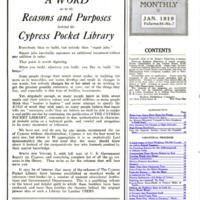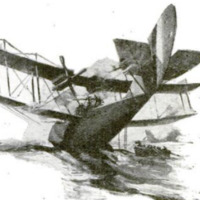An airplane invented by Glenn Curtiss was used by the British Army during World War I
Item
-
Title (Dublin Core)
-
An airplane invented by Glenn Curtiss was used by the British Army during World War I
-
Article Title and/or Image Caption (Dublin Core)
-
Title: Real Flying Dutchmen
-
Subtitle: Mammoth air-boats that are at home in air and water
-
extracted text (Extract Text)
-
THE first man who
gave really seri-
ous thought to
flying across the Atlan-
tic—serious in the sense
that he actually built a flying-machine
to carry out his intentions —was Glenn
H. Curtiss. He decided that his
machine must have an enormous
radius of action, and to obtain it he
considered it necessary not only to
increase the size of the airplane, but
also to improve its efficiency.
The chief obstacle to an increase of
its efficiency was the landing gear.
The sheer weight and air resistance
of that appendage wasted fuel. But
when Curtiss considered the crew,
particularly their comfort and safety,
he went to the other extreme, and de-
cided to turn the landing gear into a
vessel as big as a sea-going launch.
The boat or launch proved to be so
heavy that before the machine could
get into the air it was found neces-
sary to leave behind most of the fuel.
Later he adopted the “sea-sled” type
of boat. While Curtiss was still ex-
perimenting the world war broke out.
He sold his experimental craft —the
America—to the British Government,
which used it very successfully in
patrolling the waters around the British
Isles.
Curtiss gave to the world a craft
that had some of the attributes of
both airplane and dirigible, alternately
flying and resting on the water.
Small flying-boats cannot live on
the ocean, and to become relatively
seaworthy, seaplanes must have
sealed catamaran floats, and the
men must be raised high above the
waves. Only a mammoth craft,
something with a huge hull, something
that will transform the flying-boat into
a flying galleon, can solve the problem.
These huge flying galleons, as war
progress has finally shaped them, rival
in beauty the most picturesque old-
fashioned ships. With their wings
suggesting low-rigged ancient sails,
they resemble the pigmy vessels in
which the daring pioneer navigators of
the fifteenth and sixteenth centuries
crossed the Atlantic. Every structure
becomes beautiful when once it is per-
fectly adapted to its purpose. These
new flying-boats are beautiful for the
very feature that makes them prac-
tical —their raised tails. What is it
that an oarsman must know before he
can safely venture out upon a big body
of water? That he must cut the waves.
Our galleons of the air are dirigible
floating weather-cocks. From their
rounded compact hulls waves dash off
as harmlessly as from the caravels of
Columbus or from Hudson's Half-
Moon. They head into the wind as
quickly as a high-forecastled, high-
pooped ship of old, which was likewise
a floating weather-vane. Their high
tails, when they rest on the water,
head them into the teeth of the wind.
If the descent is too steep, the nose
may be tilted up, yet the high tail
drop clear of the water without splash-
ing and without breakage. Alighting
is a more delicate operation in a sea-
plane than in a landplane. It is only
too easy to come down nose first. Let
the pilot beware lest the prow be
caught in the water and the machine
turn a somersault.
It certainly seems a most interest-
ing coincidence that ships that in
truth navigate alternately the sea and
sky have now assumed the identical
and fascinating appearance of the
legendary Flying Dutchman.
-
Contributor (Dublin Core)
-
Carl Dienstbach (Article writer)
-
Language (Dublin Core)
-
eng
-
Date Issued (Dublin Core)
-
1919-01
-
pages (Bibliographic Ontology)
-
61
-
Rights (Dublin Core)
-
Public domain (Google digitized)
-
Archived by (Dublin Core)
-
Davide Donà
-
Marco Bortolami (editor)
 Popular Science Monthly, v. 94, n. 1, 1919
Popular Science Monthly, v. 94, n. 1, 1919




